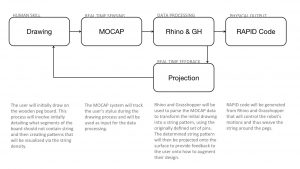Stephanie Smid and Sarika Bajaj
project context | motivation | scope | implementation
Our project involves creating a hybrid workflow that combines human drawing skill and robotic assembly for peg loom weaving. Through this workflow, artists should be able to draw patterns with specified string densities that a robot will solve for and manually string around a loom.
—

The inspiration for this project originally came from the fabrication processes of peg loom weaving and string art; the first is the base of most weaving techniques and involves weavers densely binding and patterning string across a row of pegs, and the latter is a more experimental result of peg loom weaving where artists focus more on creating patterns via the density of the string instead of the string itself. The closest case study for this project is the Silk Pavilion Project from the MIT Media Lab, where researchers used a CNC machine to manually attach string to a metal frame lined with pegs and then placed silkworms on top to fill in the structure.

Our spin on these experimental weaving techniques is to create a workflow where a person’s drawings gets processed and translated into a string density pattern that a robot weaves on a set of pegs. The person will first draw on the empty peg board, detailing gaps where no string is to be weaved and then detailing areas of higher density and patterns. The MOCAP set up in the design lab will track the stylus which the person is using to draw and will be used to create a real-time projection of the string patterning created by the drawing. Once the person is satisfied with the projected string pattern, the robot will then use string, covered in UV curing resin, to create the pattern on the peg board. The final step will simply involve using UV light to curve the final string shape and to remove the pattern from the peg board. The initial peg boards will be flat, two dimensional sheets; however, if we are able to successfully create this two dimensional workflow, then we will start transitioning to three dimensions using peg boards with slight curves and angles to further distort the string patterning. Below are early diagrams exploring how the system can work.

The following is a visual of the weaving system:

The following is an explicit workflow diagram detailing the process:
